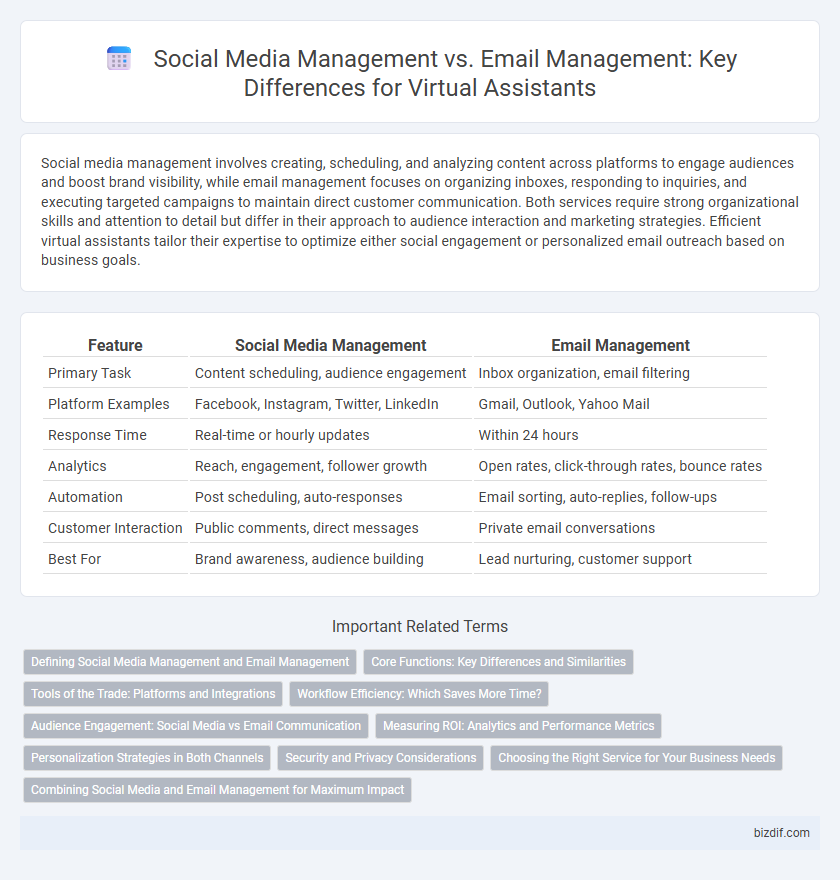Social media management involves creating, scheduling, and analyzing content across platforms to engage audiences and boost brand visibility, while email management focuses on organizing inboxes, responding to inquiries, and executing targeted campaigns to maintain direct customer communication. Both services require strong organizational skills and attention to detail but differ in their approach to audience interaction and marketing strategies. Efficient virtual assistants tailor their expertise to optimize either social engagement or personalized email outreach based on business goals.
Table of Comparison
| Feature | Social Media Management | Email Management |
|---|---|---|
| Primary Task | Content scheduling, audience engagement | Inbox organization, email filtering |
| Platform Examples | Facebook, Instagram, Twitter, LinkedIn | Gmail, Outlook, Yahoo Mail |
| Response Time | Real-time or hourly updates | Within 24 hours |
| Analytics | Reach, engagement, follower growth | Open rates, click-through rates, bounce rates |
| Automation | Post scheduling, auto-responses | Email sorting, auto-replies, follow-ups |
| Customer Interaction | Public comments, direct messages | Private email conversations |
| Best For | Brand awareness, audience building | Lead nurturing, customer support |
Defining Social Media Management and Email Management
Social media management involves creating, scheduling, analyzing, and engaging with content posted on platforms like Facebook, Instagram, and LinkedIn to enhance brand presence and audience interaction. Email management focuses on organizing, responding to, and automating email communication to improve customer relationships and streamline workflows. Both tasks require specialized skills in communication and technology to optimize digital engagement and efficiency.
Core Functions: Key Differences and Similarities
Social media management centers on content creation, scheduling, audience engagement, and performance analytics across platforms like Facebook, Instagram, and Twitter, while email management involves organizing inboxes, filtering messages, responding to inquiries, and executing targeted email campaigns. Both require strategic communication skills, timely response capabilities, and data-driven optimization to enhance user interaction and brand awareness. Core similarities include maintaining consistent messaging and fostering customer relationships, though social media demands real-time interaction versus the more structured, personalized outreach of email management.
Tools of the Trade: Platforms and Integrations
Social media management tools like Hootsuite and Buffer streamline content scheduling across platforms such as Facebook, Instagram, and Twitter, offering robust analytics and audience engagement features. Email management platforms, including Mailchimp and Constant Contact, focus on automation, segmentation, and personalized email campaigns with seamless CRM and e-commerce integrations. Integrating social media and email management tools maximizes marketing efficiency by synchronizing user data and enabling cross-channel communication strategies.
Workflow Efficiency: Which Saves More Time?
Social media management automates content scheduling, engagement tracking, and analytics, streamlining repetitive tasks to save significant time. Email management often requires personalized responses and prioritization, which can be more time-consuming despite filtering tools. For workflow efficiency, social media management generally reduces time spent managing platforms, while email management demands more ongoing attention and manual effort.
Audience Engagement: Social Media vs Email Communication
Social media management drives audience engagement through real-time interactions, visual content, and community building on platforms like Instagram, Facebook, and Twitter, fostering immediate feedback and viral sharing. Email management, by contrast, offers personalized, direct communication with segmented audiences, enabling targeted campaigns and higher conversion through tailored messaging and measurable open and click rates. Leveraging both channels strategically enhances overall audience connection by combining social presence with intimate, data-driven email outreach.
Measuring ROI: Analytics and Performance Metrics
Measuring ROI in social media management involves tracking engagement rates, click-through rates, follower growth, and conversion rates through platforms like Facebook Insights and Google Analytics. Email management ROI focuses on open rates, click-through rates, bounce rates, and subscriber growth using tools such as Mailchimp and HubSpot analytics. Comparing these performance metrics allows virtual assistants to optimize campaigns and allocate resources effectively for maximum return on investment.
Personalization Strategies in Both Channels
Personalization strategies in social media management leverage dynamic audience segmentation and real-time interaction metrics to tailor content that boosts engagement and brand loyalty. In email management, advanced data analytics enable personalized subject lines, send times, and content that increase open rates and conversion by directly addressing user preferences. Both channels utilize AI-driven insights to refine personalization, ensuring messages resonate effectively within different user environments.
Security and Privacy Considerations
Social media management requires stringent security protocols to protect accounts from hacking, unauthorized access, and data breaches due to their public and interconnected nature. Email management demands robust encryption and spam filtering to safeguard sensitive information and prevent phishing attacks targeting private communications. Prioritizing multi-factor authentication and regular security audits enhances privacy in both domains, mitigating risks associated with digital communication platforms.
Choosing the Right Service for Your Business Needs
Social media management drives brand visibility and customer engagement through platforms like Facebook, Instagram, and Twitter, ideal for businesses targeting active online communities and real-time interaction. Email management optimizes personalized communication, nurturing leads and retaining customers via newsletters and automated campaigns, suited for businesses focusing on direct, measurable ROI and long-term relationships. Assess your business goals, audience behavior, and communication style to choose the virtual assistant service that maximizes marketing effectiveness and operational efficiency.
Combining Social Media and Email Management for Maximum Impact
Combining social media management and email management leverages the strengths of both platforms to maximize audience engagement and conversion rates. Social media drives real-time interactions and brand visibility, while email management enables personalized communication and targeted campaigns based on user behavior. Integrating these strategies enhances customer retention, boosts ROI, and creates cohesive marketing funnels that amplify overall business growth.
Social media management vs Email management Infographic

 bizdif.com
bizdif.com